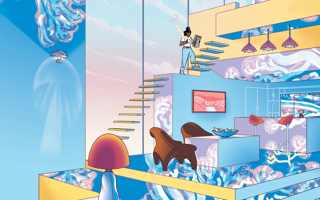Silver Medals
The Royal Academy of Engineering Silver Medal was established in 1994 to recognise an outstanding personal contribution to British engineering that has resulted in successful market exploitation.

Dr Sithamparanathan Sabesan, CEO, PervasID Ltd
PervasID is the result of Dr Sabesan’s groundbreaking work as a PhD student at the University of Cambridge. His work in the area of battery-free radio frequency identification (RFID) tag tracking has been internationally recognised and has resulted in four patents. As founder and CEO, Dr Sabesan successfully grew PervasID from its inception to become a global enterprise.
RFID systems use electromagnetic fields to automatically identify and wirelessly track tags that are attached to assets. They conventionally suffer from ‘dead spots’ where tags are not detected well within the range of the reader. PervasID overcomes this problem and achieves near 100% accuracy in detecting battery-free tags to less than one metre over wide areas. In commercial trials against all other competitors, PervasID achieved more than 99% tag detection accuracy over a 20-metre distance compared with 80% achieved over 2-metre to 3-metre distance using conventional approaches.
Dr Sabesan’s customers include the largest aircraft manufacturers, Stanley Black & Decker, blue chip retailers, and NHS hospitals including Guy’s and St Thomas’ in London. Stanley Black & Decker also use the tags to track supplies from their tool cabinets used by aircraft manufacturers. Each cabinet contains over 1,000 tools, and it can result in serious safety incidents if any are left inside an aircraft. It is estimated that foreign object debris (FOD) costs the aviation industry
$13 billion per year in direct and indirect costs, including flight delays, plane changes and fuel inefficiencies. In healthcare, PervasID solutions are being deployed in NHS hospitals for tracking surgical instruments to enhance decontamination and sterilisation processes and for tracking hospital assets to ensure that mission critical medical devices are available at the right place and time, for robust and efficient care. The need for this level of traceability of medical devices has been particularly evident in the COVID-19 pandemic. The solution is predicted to save billions for NHS hospitals and will save lives.
Dr Sabesan won a Royal Academy of Engineering Engineers Trust Young Engineer of the Year award, the Sir George Macfarlane Medal 2016 for excellence in the early stage of his career, an Engineering Enterprise Fellowship and most recently in 2021 has been awarded a Queen’s Award for Enterprise: Innovation.

Dr Andrew Lynn, CEO, Fluidic Analytics
Dr Andrew Lynn is a materials engineer, inventor and entrepreneur. He has founded four engineering companies based around his innovations, and brought several technologies to market, including a regenerative medical implant for cartilage and bone repair.
In his current role as CEO of Fluidic Analytics, Dr Lynn has been responsible for leading the company’s progression from a promising idea, through product development, to producing research and diagnostic products for characterising protein interactions. Two of these products have been launched commercially and one has made fundamental contributions to breakthroughs in the understanding of the mechanisms of action of drugs for Alzheimer’s Disease. The products have also enabled a 40-patient clinical study to be conducted at University Hospital Zurich into how antibodies protect the body against COVID-19. The clinical study was featured on BBC News in October 2020.
In addition to the impact it has made in medicine, Fluidic Analytics has created 96 full-time jobs, filed or licensed 19 patents and attracted £35 million in investment.
Dr Lynn’s work has resulted in over 20 peer-reviewed publications and eight international patent families. He has been recognised with an ACES Academic Enterprise Award and a spot in MIT Technology Reviewmagazine’s prestigious list of the world’s top innovators under 35. Chondromimetic, an orthopaedic implant that Dr Lynn developed during his PhD, was a finalist for the MacRobert Award 2009.
.png)
Dr Tom Carter, CTO, Ultraleap
Dr Tom Carter invented a technology that uses ultrasound to create tactile sensations on bare hands. Sound waves from a collection of small ultrasonic speakers are focused onto the user’s hands, causing the skin to vibrate and elicit the sensation of touch.
His groundbreaking technology enables entirely new user interfaces and experiences, making interaction with virtual objects and applications possible. The technology can be used in any market where a user interacts with a device or appliance. It’s recently been used to demonstrate automotive safety with Groupe PSA and the DS Aero Sport Lounge Concept Car, and for immersive entertainment with LEGO, where participants could feel and build with virtual LEGO bricks in mid-air.
Dr Carter was inspired by the commercial viability of gesture recognition as a new way to interact with machines during his undergraduate degree at the University of Bristol. He wanted to find a way to add the sense of touch so that users could feel the virtual objects that they were interacting with, without having to wear gloves or hold controllers.
The core innovation behind Dr Carter’s mid-air haptic solution is based on complex patented algorithms that carefully control ultrasound, projecting tactile sensations directly onto a user’s hands. He founded Ultrahaptics Limited in November 2013.
In May 2019, Ultrahaptics acquired world-leading hand-tracking company Leap Motion. It subsequently rebranded to Ultraleap, where Dr Carter remains CTO and continues to lead the company in all technology advancements.
Dr Carter won the Colin Campbell Mitchell award with his two co-inventors in 2016.
Keep up-to-date with Ingenia for free
SubscribeOther content from Ingenia
Quick read

- Environment & sustainability
- Opinion
A young engineer’s perspective on the good, the bad and the ugly of COP27

- Environment & sustainability
- Issue 95
How do we pay for net zero technologies?
Alex Keeler: Electrifying trains and STEMAZING outreach

- Civil & structural
- Environment & sustainability
- Issue 95